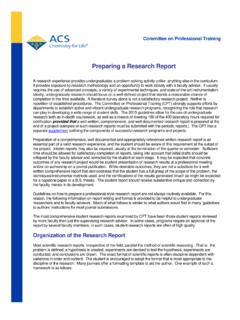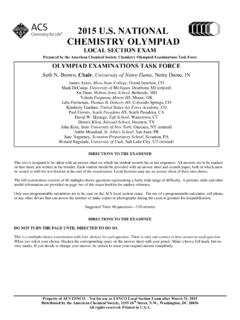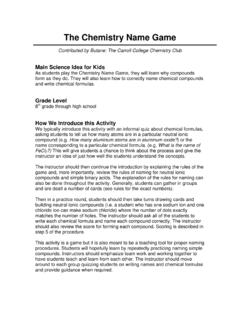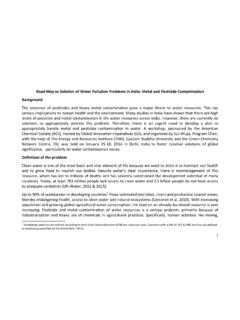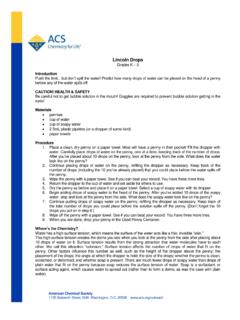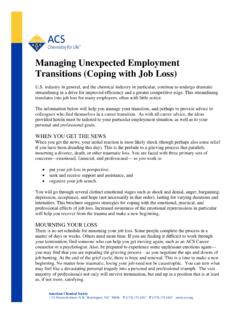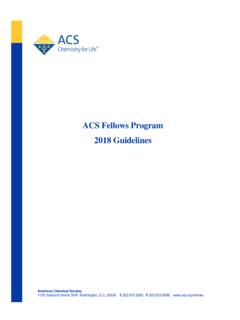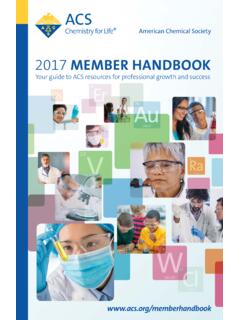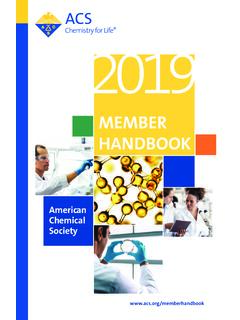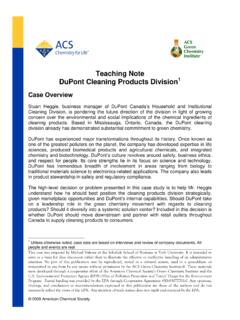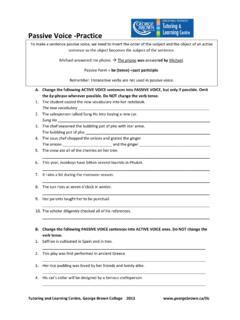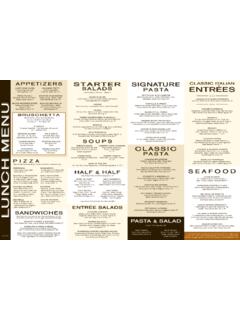Transcription of The Chemistry of Food Colorings - American Chemical …
1 He link between color and taste is logical. Since oranges are orange, we expect orange-colored drinks to be orange-flavored. Red drinks should taste like cherries, and pur-ple drinks should taste like grapes. If a food is multicolored, it could be moldy and should not be eaten, unless you are eating blue cheese which gets its distinct flavor from mold!An astonishing amount of the foods we eat is processed. These foods are altered from their natural states to make them safe, say, to remove harmful bacteria, or to make them appeal-ing and to prolong their shelf life.
2 About 70% of the diet of the average resident is from processed foods. Much of what we eat would not look appealing if it was not colored. Think of food coloring , also called food dye, as cosmetics for your food . Without coloring , hot dogs would be gray. Yum!Natural food coloringTo avoid so much processed food , some people have advocated using natural food coloring , whenever possible. Natural food dyes have been used for centuries to color food . Some of the most common ones are carotenoids, chlorophyll, anthocyanin, and have a deep red, yellow, or orange color.
3 Probably the most common carotenoid is beta-carotene (FIg. 1), which is responsible for the bright orange color of sweet potatoes and pumpkins. Since beta-carotene is soluble in fat, it is a great choice for coloring dairy products, which typically have a high fat content. So beta-carotene is often added to margarine and cheese. And, yes, if you eat too many foods that contain beta-carotene, your skin may turn orange. Fortunately, this condition is is another natural pigment, found in all green plants. This molecule absorbs sunlight and uses its energy to syn-thesize carbohydrates from carbon dioxide and water.
4 This process is known as photo-synthesis and is the basis of life on Earth. Mint- or lime-flavored foods, such as candy and ice cream, are sometimes colored using best natural source for deep purple and blue colors is anthocyanin. Grapes, blueber-ries, and cranberries owe their rich color to this organic compound. Unlike beta-carotene, anthocyanins which form a class of com-pounds rather than a single Chemical com-pound are soluble in water, so they can be Would you drink black water? Clear Pepsi? How about using pink butter or green ketchup? Believe it or not, these products actually existed, and not that long ago either.
5 But there is a reason these food fads did not last. Consumers prefer that the color of food matches its ; RHONDA SAUNDERS; ; DOLLAR PHOTO CLUBSHUTTERSTOCKThe Chemistry of food Colorings By Brian RohrigChemMatters | OCTOBER/NOVEMBER 2015 5H3C H3C H3C CH3CH3CH3CH3CH3CH3CH3 Figure 1. Beta-carotene is composed of two small six-carbon rings connected by a chain of carbon to color water-based products. Blue corn chips, brightly colored soft drinks, and jelly are often dyed with than 500 different anthocyanins have been isolated from plants. They are all based on a single basic core structure, the flavylium ion (Fig.)
6 2). This ion contains three six-carbon rings, as well as many hydroxyl ( OH) groups that make the molecule polar (it has partially negative and partially positive charges) and , anyone?The next time you enjoy strawberry- flavored yogurt or cranberry juice, you may be eating bugs! But don t worry. These insects did not contaminate your food by accident. An extract from a type of insect, known as the cochineal, was deliberately added by the food centuries, the Aztecs used these insects to dye fabrics a deep-red color. If you crush up 70,000 of these bugs, you can extract a pound of a deep-red dye, called carminic acid (C22H20O13) (Fig.
7 3). This dye is safe to ingest, so it found its way into a variety of food and cosmetic products that required a red color. However, the thought of eating bugs is unappealing to some people. Starbucks formerly used cochineal dye in its strawberry-flavored products, but it has since removed this dye in response to customer complaints. To find out if your food contains bugs, look for carmine, carminic acid, cochineal, or Natural Red 4 on the ingredient label. While these substances are typically considered safe, in rare instances, people can have a severe aller-gic reaction to them, leading to a life-threaten-ing condition called anaphylactic go artificial?
8 Why bother with artificial, or synthetic, food Colorings ? Aren t there enough natural colors to go around? A big reason to go artificial is cost. Synthetic dyes can be mass-produced at a fraction of the cost of gathering and pro-cessing the materials used to make natural food reason is shelf life. Artificial food dyes might be longer-lasting than natural ones of the same color. Also, although nature produces an impressive hue of colors, those suitable for use as a food dye are limited. But there is no limit to the variety of colors that can be artificially produced in a lab.
9 Considering the thousands of different substances that color our food , it may come as a surprise to discover that the food and Drug Administration granted approval to just seven synthetic food Colorings for widespread use in food . These food Colorings are summarized in Table food Colorings were originally manufactured from coal tar, which comes from coal. Early critics of artificial food color-ings were quick to point this out. Today, most synthetic food dyes are derived from petro-leum, or crude oil. Some critics may argue that eating oil is no better than eating coal.
10 But the final products are rigorously tested to make sure they contain no traces of the origi-nal petroleum. One dye that does not have a petroleum base is Blue No. 2, or indigotine, which is a synthetic version of the plant-based indigo dye, used to color blue to color foodWhat makes a good food coloring ? First, when added to water, it must dissolve. If the dye is not soluble in water, it does not mix evenly. When a typical solute, such as salt or sugar, is added to water, it dissolves, meaning it is broken down into individual ions or molecules. For instance, individual molecules of sugar (C12H22O11) are held together by relatively weak intermolecular forces.
